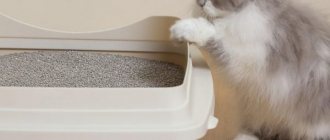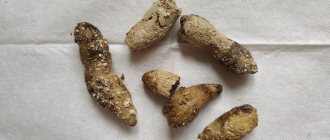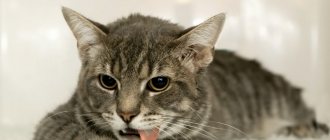Every owner has probably encountered such a nuisance as cat wounds, but not everyone can know about their types and methods of treatment. And this is very important, since with sufficient information you can avoid problems and not aggravate the condition of your pet.
An animal can get wounds both at home and in street fights with other cats or even dogs. And before proceeding with their processing and treatment, it is important to assess their origin, namely size, depth and possibility of infection. First, you should learn about the types of wounds.
How to tell if a cat has wounds
All wounds, regardless of their types, have common symptoms:
- Bleeding to a greater or lesser extent, depending on the type of wound. The most bleeding ones are stabs, cuts and crushed ones.
- The integrity of the skin is compromised. It is difficult to immediately recognize a bite or puncture wound because the entrance hole is very small. This can be done by looking at the cat’s wet fur.
- Lack of fur in a certain area.
- Presence of edema.
- Painful sensations, during which the animal behaves restlessly and often licks the place where the wound appeared.
With complicated wounds, redness around the lesion, suppuration, increased temperature, and even the development of an abscess can be observed.
In cats, purulent, open and lacerated wounds most often occur. But regardless of their size and whether the cat can be treated at home or you will have to seek help from a veterinarian, you will need to treat the wound by first shaving the hair around it. It is recommended to give preference to safe chlorhexidine for treating wounds rather than iodine or brilliant green, which can cause burns to the skin and internal tissues. It is also necessary to free the wound from foreign objects, and then apply a sterile bandage. If treatment is neglected, pathogenic bacteria will enter the wound and suppuration cannot be avoided. And in this case, more serious and lengthy treatment will be required.
The essence of eczema and its manifestations
Eczema in cats is an inflammatory disease affecting the epidermis (the top layer of skin). It manifests itself in the form of an itchy rash, gradually transforming into blisters with purulent contents.
The pathology is not contagious to other domestic animals and is not transmitted to humans. Despite this, when treating purulent ulcers, it is recommended to use protective gloves and wash your hands thoroughly after each contact.
Otherwise, pus containing pathogenic microorganisms can get into microcracks in the skin or mucous membranes and cause inflammation. This situation is very rare, but you should not exclude its possibility and neglect basic safety rules.
Treatment at home for a purulent wound
Purulent wounds in cats can be open or closed. It is good when the wound is open, since pus can flow freely from it. It is worse when the wound is closed and has turned into an abscess - a cavity with an accumulation of pus.
You can identify a festering wound yourself. There will not only be swelling and pain in the cat, but also pus will leak if the wound is open or an abscess will appear if it is closed. The cat may also have a fever and the temperature will rise.
The veterinarian may prescribe a microbiological examination for the animal, for which pus is taken from the wound at its maximum depth.
As for treating a purulent wound in a cat, the method is selected depending on whether it is open or closed. In any case, the wound is cleaned of dead tissue, all accumulated pus is removed from it, and its outflow is ensured. A bandage is applied with wound healing ointment.
With an abscess everything is more complicated. It will be necessary to open it, and then install a drainage to ensure the free removal of pus from the wound, as well as to prevent the cat’s wound from re-healing. It is better if this manipulation is carried out by a veterinarian in a clinic, and then the owner will have to care for the wound and treat it at home.
How are purulent wounds treated on cats? An antiseptic solution and regular dressings with a wound-healing ointment, such as Levomekol, are well suited for washing. A veterinarian should monitor the wound healing process.
Along with these medications, it is recommended to give the cat an antibiotic according to the regimen prescribed by a specialist, and painkillers to relieve pain.
Classification of the disease according to its causes
Due to the occurrence of eczema in cats, it is divided into 4 large groups. Despite the similar symptoms, they all require different treatment methods.
Traumatic
This form of pathology occurs when insect bites and any injuries (frostbite, burns, friction of the collar) affecting the skin. In most cases, it develops as a weeping ulcer.
Neuropathic
The neuropathic form develops against the background of disturbances in the functioning of the autonomic nervous system, which is responsible for the reaction of internal organs to stimuli. It is caused by congenital genetic pathologies and some infections (distemper), which give complications to the central nervous system.
May manifest as peeling or erosive formations. It responds poorly to drug therapy and has a poor prognosis.
Reflex
Occurs when hypersensitivity to certain irritants (fabrics, detergents, pollen, food, flea saliva). This reaction of the body is called atopic dermatitis. This form is treated with antihistamines, which suppress the main symptoms.
Arising due to internal reasons
Internal causes include pathologies of the urinary tract, prolonged stress, diseases of the gastrointestinal tract, helminthiases and infections. The risk group includes animals with chronic diseases, elderly pets and kittens with weak immune systems.
What to do if your head wound is festering
If a cat has a festering wound on its head, all manipulations to eliminate suppuration should be carried out very carefully. First you need to free the surface near the wound from hair and dried pus. The wool is cut and the crusts are soaked in 3% hydrogen peroxide. Under no circumstances should they be scraped off or the pus squeezed out. And do not put your hands into the wound, so as not to aggravate your pet’s condition. If foreign objects are found in the wound, carefully remove them with tweezers. There is no need to touch the remaining skin around the edges of the wound; take the cat to the vet as is. And if he deems it necessary, he will delete them himself.
Cat care
A cat that has wounds should receive maximum care and peace of mind until complete recovery.
. During this period, it is advisable to protect the animal from contact with other pets, as well as from visits to the street. Do not allow the animal to lick or scratch the wound, bandage or stitches, or tear the damaged area. To ensure that the wound has the opportunity to dry out and the cat cannot tear it, you can put on a special collar.
The bandage should always be clean and dry, and it should be changed in accordance with the recommendations of a specialist at the veterinary emergency center. At the first stage, this can happen 2-3 times a day, and then less often. It all depends on how quickly the wound heals and its complexity.
A fairly important part of the rehabilitation process when a wound occurs in cats is the pet’s nutrition. Food must be balanced so that the body receives a sufficient amount of nutrients and can actively fight infection. You should not feed your animal food that is irritating. These products include smoked meats, sausages, and various sweets. The diet should contain a sufficient amount of vegetables and nutrients that will increase the level of the immune system. The veterinarian at the Ya-VET emergency center can prescribe vitamin complexes to improve the general condition of the animal.
Treatment at home for an open wound
Treatment of open wounds on a cat begins with the generally accepted principles of treatment, namely by cleansing them of dirt, debris and all foreign bodies. And only then is treatment with an antiseptic drug carried out.
Its subsequent healing depends on how correct the treatment of an open wound is. Excellent antiseptics are chlorhexidine, fucorcin and furatsilin. They are safe and do not cause burns upon contact with the affected area.
Open wounds should not be treated with iodine, brilliant green and alcohol-containing preparations, as they can aggravate the condition of the wound, causing a chemical burn. They are only suitable for treating the skin around the wound.
If your pet has an open wound, first aid should be provided by a veterinarian, because very often the wound needs to be sutured. But if more than twelve hours have passed since the injury, then suturing is no longer done.
Diagnosis of the problem and difference from similar skin diseases
Before you understand exactly how to treat eczema in a cat, you need to establish its cause. Do not treat the affected area with medications before going to the veterinary clinic - using ointments and sprays without prescription will either blur the symptoms and complicate the doctor’s work, or will aggravate the existing problem.
The symptoms of the pathology are similar to ringworm and demodicosis, which require completely different treatment. In the first case, deformation of the claws occurs, in the second, scabs appear in the lesions, protecting the wounds from secondary infections. In both pathologies, hair falls out slowly, and the affected area quickly increases.
For eczematous lesions, the situation is the opposite: rapid baldness and slow growth of erosion. Remember that shingles is transmitted to humans, and try to avoid close contact until a diagnosis is made.
The main diagnostic methods include blood tests, skin scrapings and ultrasound. These studies help to identify deviations in basic indicators, assess the condition of internal organs, and determine the causative agent of infection or other provoking factors. The presence of helminthiasis is confirmed or refuted using stool and urine tests.
How to treat a wound on a cat with bleeding
If a cat is injured and has bleeding, you need to act differently, depending on what part of the body was injured:
- If there is bleeding from a wound on the paw, apply a tourniquet immediately. It can be made from a bandage, tape, rope, fabric or rubber tape, bandaging the paw above the wound. If the bleeding has not stopped, then it is venous, and a tourniquet must be applied below the wound. An alternative to a tourniquet can be a cotton-gauze bandage soaked in a vinegar solution, which is applied to the wound for several days.
- If there is bleeding on the neck or torso, the wound must be covered with a napkin or gauze soaked in a herbal decoction of calendula, coltsfoot or chamomile and a tight bandage must be made, but so that the cat can breathe normally.
- If there is bleeding in the peritoneum, you should not give the animal water, but after bandaging it, apply a cold compress to the abdomen. If the bleeding is accompanied by vomiting blood or if it is in the lungs, the cat should be given cold water, but not fed.
Classification by type of manifestation
Symptoms and treatment of eczema in cats directly depend on the type of its manifestation. The most dangerous are bursting pustules, which increase the affected area and cause tissue death.
Wet look
This species is easily identified by its wet and shiny surface. Bubbles with pus burst on their own or under the influence of sharp claws scratching the skin until it bleeds. The weeping lesion is not limited to one area and gradually grows, forming a huge ulcer oozing with pus or ichor.
Dry look
If the exudate resolves, the papules gradually harden and peel off. The skin at the site of the lesion begins to peel off and dandruff forms. This type of eczema in cats is called dry. Its main danger is the possibility of degeneration into a weeping appearance due to inflammation of the scratches. For this reason, it is recommended to treat the disease already at the erythematous stage.
How to treat if the wound does not heal on the paw
It happens that a cat has injured its paw and quite some time has passed, but the wound still does not heal. In this case, it is imperative to treat it with medications so as not to lead to severe infection. Sometimes a similar situation occurs when suppuration begins. Treatment will be required for disinfection three times a day and only then wound healing.
It is very important not to allow the cat to lick the wound, because he may thereby lead himself to repeated suppuration. To do this, cover the wound with a sterile bandage and seal it with a plaster. And you should definitely take your pet to the vet. In especially severe cases, it is impossible to do without laser irradiation of the wound, injections of antibiotics, special vitamins and food to promote its speedy healing. The main thing is to understand the seriousness of the cat’s injury and treat it responsibly.
Varieties according to flow form
Another classification is based on the form of the course, that is, the speed of development and severity of symptoms. The most favorable prognosis is typical for the acute form.
Acute
The acute course is characterized by the sudden appearance and rapid increase of all of the listed symptoms. Kittens often suffer from this form.
Despite their weak immunity, they recover quite quickly soon after starting drug therapy. This is explained by the timely detection of the disease and the small number of pathological changes inside the body.
Subacute
The subacute form develops after 1-1.5 months as a complication of the acute form. It is difficult to treat and often becomes chronic.
Chronic
Unlike acute and subacute, the chronic form is rarely accompanied by wet ulcers. It is characterized by constant peeling and partial baldness. Chronic pathology often occurs in older cats and pets weakened by concomitant diseases.
This disease is practically incurable and can last for years, accompanied by a series of remissions and relapses. To improve the condition of a sick animal, maintenance therapy is used.
When to go to the veterinary clinic
You should contact your veterinarian if you have the following signs:
- prolonged bleeding from the wound;
- damage where meat and torn pieces of skin are visible;
- increased body temperature in the pet, lethargy, lack of appetite;
- the appearance of vomiting and diarrhea;
- wounds with a large area;
- gunshot wounds;
- the appearance of swelling and redness in the affected area;
- pus or abscess;
- in case the pet is bitten by a tick;
- if your pet has been bitten by a snake and there is poison in the wound.
Important! If, as a result of home treatment, the wound does not improve within a few days, you should consult a doctor.










